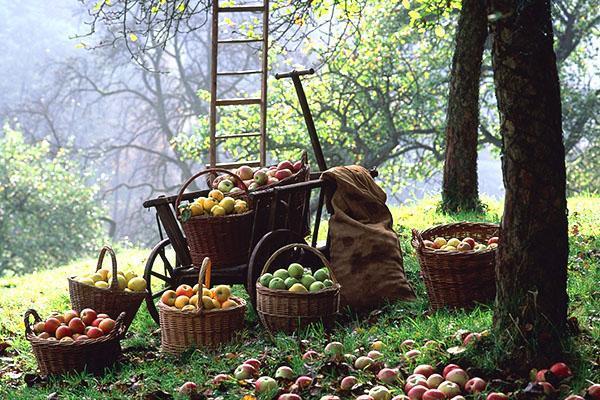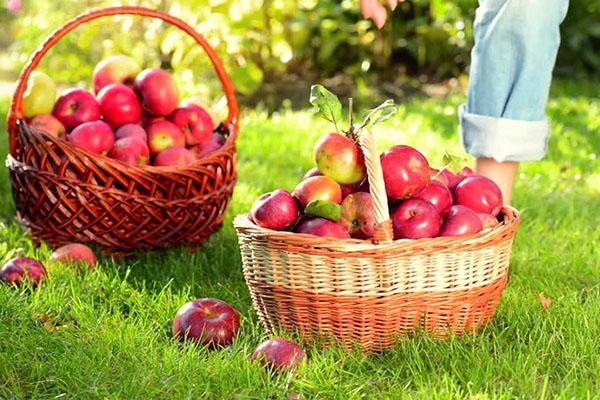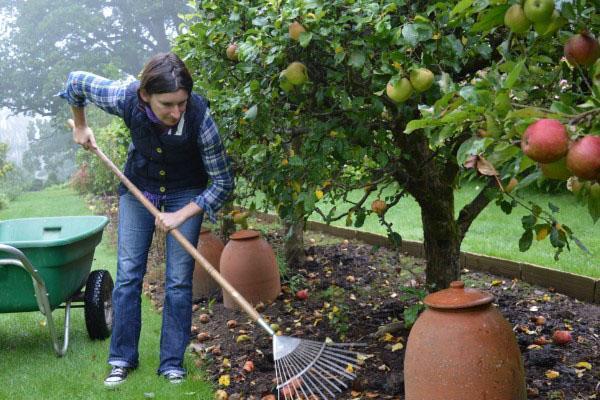The summer resident's troubles in the garden with the arrival of September
 The garden is freed from harvest in September, delighting the summer resident with autumn and winter varieties of apples and pears, late plums, the second harvest of raspberries, grapes. When the branches are empty, preparations for winter follow, and the planting of young trees and shrubs continues.
The garden is freed from harvest in September, delighting the summer resident with autumn and winter varieties of apples and pears, late plums, the second harvest of raspberries, grapes. When the branches are empty, preparations for winter follow, and the planting of young trees and shrubs continues.
The chores around the garden at this time can only be compared with the hard work of spring. Everyone needs the attention of the summer resident, without exception plants. Read the article:preparing grapes for winter in autumn.
Taking care of fruit trees in September

In order to feast on fruits from your garden in autumn and winter, it is better to pick them gradually, removing only those that are really ready to leave the branches. Crop is harvested in calm dry weather, immediately laid out in clean boxes or baskets.
Can't mix removable apples and pears with carrion, possibly infested with insects, inseminated by putrefactive bacteria and fungi. Fruits with stalks are better stored, but trying to preserve them, you should not be zealous. If a fetus suffers during a cliff, this will affect the number of ovaries next year.
 When the tree is completely freed from its summer burden, the props are removed. If they are infected with fungus or lichens, they should be burned. Stationary structures are disinfected, dried and cleaned until the next season. After harvest:
When the tree is completely freed from its summer burden, the props are removed. If they are infected with fungus or lichens, they should be burned. Stationary structures are disinfected, dried and cleaned until the next season. After harvest:
- fallen fruits are removed from under the trees;
- tear off the ovaries dried up on the branches;
- collecting and burning broken branches and fallen leaves;
- mow the grass;
- cut out the growth at the base.
Watering and fertilizing the garden in September
 September in the garden is a good time to feed fruit trees and shrubs. Potassium and phosphorus will help plants not only stop their strength, but also prepare for wintering. Nitrogen fertilizers cannot be used, since nitrogen provokes the growth of greenery and the formation of new shoots. Such a growth, not having time to ripen, will inevitably die in the cold and weaken fruit crops.
September in the garden is a good time to feed fruit trees and shrubs. Potassium and phosphorus will help plants not only stop their strength, but also prepare for wintering. Nitrogen fertilizers cannot be used, since nitrogen provokes the growth of greenery and the formation of new shoots. Such a growth, not having time to ripen, will inevitably die in the cold and weaken fruit crops.
In September, it is convenient to use dry granular dressings, which are lightly embedded in the soil. Sustained-release mixtures will gradually dissolve and flow to the roots in a form that is already available for assimilation.
Before the arrival of cold weather, it is useful to water shrubs and fruit trees. This is especially important if the last summer month and the beginning of autumn were dry. The moisture boost will help the plants prepare for winter and prevent freezing. An average bush spends at least 2-3 buckets of water, trees need about 50-60 liters.
During the digging and loosening of the trunk circles, the soil in the garden is deacidified with the help of dolomite flour and wood ash.
Berry bushes in September
 By September, almost all the shrubs in the garden had already finished bearing fruit. The berries ripen only on late blackberries and remontant raspberries. So that the crop does not suffer from early frosts, the shoots are covered with non-woven material.
By September, almost all the shrubs in the garden had already finished bearing fruit. The berries ripen only on late blackberries and remontant raspberries. So that the crop does not suffer from early frosts, the shoots are covered with non-woven material.
September is a great time to prune fruit bushes.Old shoots of raspberries and blackberries are cut at ground level. Branches of currants and gooseberries older than 6–8 years old, as well as all parts of plants damaged by diseases and pests, must be removed.
Due to the emergence of cold-resistant varieties growing grapes today it is distributed not only in the southern regions of the country, but also in the middle lane. Many dessert and technical varieties ripen in September. Harvesting can be combined with pruning unripe, weak and damaged shoots. Thus, the vine will be ready to be removed from the support and sheltered for the winter.
By the end of summer, garden strawberries have formed many whiskers, which have managed to take root. Mature bushes grew up, gave new foliage, and the old one sank to the ground and dried up.
The beginning of autumn is suitable for cleaning up the berry beds, for this:
- remove wilted greens;
- young sockets are seated;
- cut out unnecessary mustache;
- parallel weeding of plantings, loosening of the soil.
Preparation for the autumn planting of fruit crops
 Autumn is the time for planting fruit and berry trees and bushes. In September, it is convenient to prepare planting pits. If you dig them out in advance, as well as prepare suitable supports and soil for backfill, the purchased seedlings with an open root system will immediately find themselves in a permanent place of residence and will perfectly endure the winter.
Autumn is the time for planting fruit and berry trees and bushes. In September, it is convenient to prepare planting pits. If you dig them out in advance, as well as prepare suitable supports and soil for backfill, the purchased seedlings with an open root system will immediately find themselves in a permanent place of residence and will perfectly endure the winter.
When planning new plantings, take into account the distance to existing perennial plants, the presence of plant protection from wind, direct sunlight and flooding.
Vine pruning is used to harvest cuttings. They are planted in a specially organized school, which is covered to protect them from frost, autumn rains and pests. Here the seedlings will take root and next year they will be ready to be transferred to a permanent place.
Good day! Strange pink sprouts have appeared on the paths in the greenhouse for several years. What is it and how to deal with it?
I cannot say for sure what it is yet. Try to dig up along with the root and photograph. Sprinkle with salt or sprinkle with a solution of salt + vinegar + water + liquid soap. Weed killers can be used.
Very similar to the dog mutinus. Mushroom from the Red Book, take care! But I do not recommend sniffing 🙂
Hello. Krasnoyarsk Territory 50 km from Krasnoyarsk. I grow blue grapes. I don’t know the variety, but some sort of Siberian, with a small amount of seeds. Does not mature, frosts up to 4 degrees are possible. What happens if the bunches of grapes are not all removed. Will it affect the quality of the grapes and the vine itself will not suffer?
Try covering the bush at night. As for me, the plant is very thickened and this may be the reason for the berries not ripening. Now in the afternoon treat with a soda solution (4 sl. L per 10 l of water) This solution works well for ripening times, reducing them. The vine will not suffer. Be sure to adjust your harvest for the next year. Two branches often grow from one bud at once. The weak one needs to be removed. Further, only two bunches are left on the branch. In the summer, pinching is carried out. As a result - larger bunches and berries, timely ripening. When the berries begin to gain color, sprinkle with a soda solution.